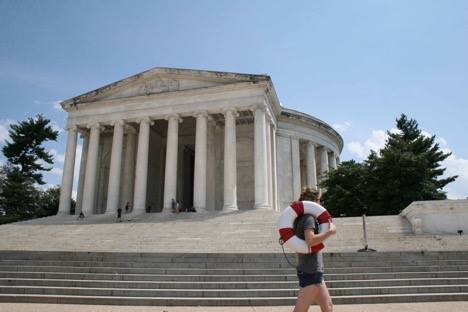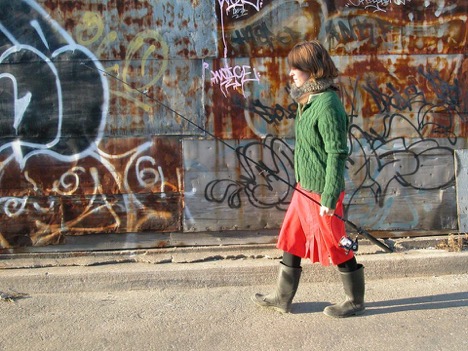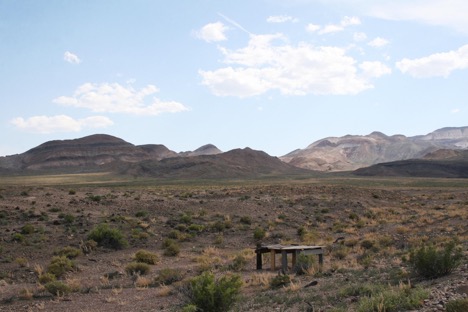By Noa West, VisArts Summer Intern, 2017
Artist Katie Kehoe of Toronto, Canada was selected to be a Fleur and Charles Bresler Resident Artist from May to September, 2017. The four-month Bresler Residency at VisArts focused this year on artists whose primary creative practice reflects vital interest or research in the areas of social practice, performance, and community engagement. Eclectic and soft spoken, I approached her studio on the second floor of VisArts for the first time not knowing what to expect. Through the glass doorway, the afternoon sunlight filters onto her organized menagerie. Salvaged nets, tarps, foam blocks, and stacks of paper accumulate along the parameters of her studio. Katie leans over her desk sanding a foam life preserver ring, wearing a neon green trucker hat that says, ‘Provisions for Buoyancy.’ Geometric drawings, maps and images of the sea cover her walls. A pair of rubber boots and a fishing rod rest next to the door. Yet, two stories above ground, she is a metaphorical fisherman, combining her love for the ocean and the environment with social practice and performance art. Katie proceeds to tell me about her work, her passion turned almost obsession, and the elements and experiences that led her to create a body of work including performances entitled Provisions for Buoyancy that will be presented in the Kaplan Gallery January 16 – February 18, 2018.
What have you been working on at VisArts?
Well I’m really fresh into the residency, I arrived under three weeks ago, so I’m just getting started. I have planned a project called Provisions for Buoyancy, and I’ll be working with materials that I’ve salvaged locally, and making provisions for buoyancy out of the materials that I’ve salvaged. For example, a life ring, a poncho— that’s not necessarily a buoyancy device but it’s helpful for the rain (laughs) and I’m planning to make a boat of some sort and accessories for it— I’m thinking of it as a shack raft, at this stage. So I’ve been retrieving a lot of materials and once I produce these provisions, I’ll be activating them in public spaces; where there isn’t water but, if the sea-level were to rise by five feet, these areas could be flooded. Most likely I’ll be activating them to fulfill that purpose of the project in low-lying areas of Washington D.C., and potentially around the harbor in Baltimore. But I also intend to be carrying them around Rockville, to use them as absurd devices to engage the public. I’m also going to be producing a series of drawings that explore this concept of expanding waterways
How has the Bresler Residency shaped your practice?
The call for artists working in social practice, performance, and engagement with sustainability and the environment really speaks to where I am in my practice. It allows me to pursue that in a really vigorous and focused way because it’s four months.
How have your works involved social practice and performance?
Performance action is almost like an intervention, but without necessarily an intention to change anything. It’s like performing an action in a public place, and then being open to seeing whatever comes from that. The duration has also been a significant tool for me in my social practice and performance work. Last spring, I produced a project called Pier-Platforms, where I traveled through the southwest for 60 days salvaging materials. I then built a pier, which I installed in unconventional locations that ranged from remote desert settings, to urban environments. It also was a platform that allowed me to continue creating what I call “performance actions.” All in all, it was a project that referenced excessive waste production, and expressed my growing uncertainty for how the climate is changing and what it really means. Yet, when I was in urban areas, the pier was used as a platform for communication and meeting. While I was in rural areas, I was there alone installing and taking photos to document the experience.
I have a passion for the water, and I think of myself as a nomad. So prior to that, I did a piece called One Year and Twenty-Four Days of Fishing, where I carried a fishing rod and wore rubber boots everywhere for over a year. I didn’t tell people it was a performance project, I just did it— the fishing rod was a catalyst for so many interactions with people. People would say ‘Where are you fishing?,’ ‘What are you fishing for?’ and I would say where I was going and what I was going to do there. Ultimately, I was really curious about going into that metaphor of fishing like, ‘What are we fishing for?’ with a deeper meaning. These recent projects have really informed what I’m doing here. These projects have been durational. I’ve been performing actions in public spaces using some kind of device that is absurd and unconventional and using that as a catalyst for interaction.
Katie Kehoe, One Year and 24 Days for Fishing, performance
What has inspired you to become passionate about climate change and emanate it through your work?
There’s a lot of origin for this work, I’ve had a lot of influences. As a little girl, I used to love fishing. I would go out every day— I lived on a lake and I would fish from morning until night. I come from a family of fishermen, and although I wasn’t raised near thar culture, I was always fascinated by it. My greatest influence would be my father—who raised my sister and me as a single parent since I was 11 ans she was 13. He taught us to stand up for what we believe in, to be independent, to value community, respect the environment, and instilled in us an intense work ethic, self-discipline, and determination.
I addition, I not only work with salvaged materials because I see so much that has been thrown out, but also because of his influence. He has also taught me most of what I know about working with wood and adaptive reuse of materials. He’s always salvaging things— he’s in an architectural salvaging business so I’ve seen how he reuses things, by taking apart old buildings and using those materials to make new things that are useful. It’s amazing what has been collected in garbage— anything you could want you can find in the garbage.
For these durational pieces, it takes an incredible amount of stamina, and I feel at this point when you are holding this object around for over a year, it’s almost like it’s a part of you.
By watching my mentors commit to their practice, I saw how committed one needs to be. You need to be committed and you need to love it. For me, you need to not be able to not do it, to be able to have the stamina that you are talking about to produce this kind of work. Also, prior to grad school, there was some work that I was exposed to in Toronto. It was really contemporary at the time, like relational aesthetic-type work which is now translated to social practice.
What does that mean?
Relational-aesthetic work is performance where the relationship, the actual conversation, is a part of the piece. Darren O’Donnell sort of coined this term, ‘social acupuncture’ because he had come out of the experimental theatre community, and was creating this work in Toronto that was really relational. I became very interested in it because it was so unconventional and unusual. I was inspired by this entering graduate school, even though I was feeling pretty lost at the time, cause you know grad school— it kind of really makes you take apart and examine all aspects of your practice. After the first semester of graduate school I, too, was feeling quite lost. That’s when I started carrying the fishing rod. That piece significantly influenced where I am now.
Did the message and meaning of your piece change and evolve after doing it for so long?
Yeah. The message and meaning of the fishing rod has really evolved and it taught me about performance. It started with a simple rule: carry a fishing rod wherever I go, and wear rubber boots every day. When I started, I hadn’t decided how long I would carry it for. Days turned into weeks and weeks into months, taught me a lot about how duration can be used as a creative device in performance. and I found that extending the duration of the performance action correlated to an increasing scale of the project. As a result of the extended duration, the project accumulated a history that enriched the piece. The longer I carried the fishing rod and wore the rubber boots, the more I learned from it by carrying it through an ever-increasing range of life experiences.
You create fabulously intricate drawings. Do you ever go through phases where you just focus on a 2D medium, or do you always combine disciplines? Are your drawings a reaction to your performance pieces, or is there a dialogue between them?
They derive from the same value and impulse in me, appreciating and investigating interconnectedness. I have been working with and writing repetitions of the word “and” since I was in my early 20s. As an undergrad, I studied international development and English, and I was writing a lot of poetry and theatre. The interaction of these two studies became the fuel and framework of my work. I started working visually when I became frustrated that no one was reading poems anymore. While studying international development, I kind of came to a personal conclusion that even the most grassroots development initiatives are driven by western values— like the colonization of the mind. As an artist, I questioned, ‘What is development, then?’ And came to a personal conclusion that development is communication. To orchestrate and explore my personal conclusion, I delved into theatre and drawings as a means to communicate. I then arrived at the word ‘and;’ I value the physical word’s purpose as a conjunction used to connect speech and thought together. Physically, the word is non-biased. It represents interconnectedness, regardless of differences between people, culture and background. It appreciates that we can relate in some level. So similarly, with the performance practice. The fishing rod for example, I would think of going out into the world as going into an “Andscape,” that being like a world of endless possibilities for interaction, revolution, and drift. I think of the social and performance practice as the ‘experience,’ and the philosophy behind the drawings that I create. The repetitions of “and” are interwoven together in my compositions; the physical shape and curves of the letters are aligned, revealing pattern and symmetry. I chose to conform these repetitions into basic shapes to emphasize the basic nature of our connectedness.
However, I’ve often felt that I have a bit of a split personality when it comes to art practice, looking at my work. Though it looks so different, I know it all derives from the same impulse. That’s why I am looking forward to this residency. I think that my performance pieces and drawings will converge in a way that they haven’t before.
What kind of conversations have you had with people when performing?
It really ranges on the project and what device that I am using. With the fishing rod, interactions did not go into the metaphor of fishing as much as I hoped, people really kept it quite literal, and they would say, ‘Where are you fishing, what are you fishing for?’ I would tell them where I was going. Some people thought that I was just being a smartass, and thought I didn’t want to tell them where I was fishing. That made me feel bad because I know that it’s not easy to reach out to strangers, and it probably took a lot of courage on their part to even ask that question. Other people went along and treated it as a joke. Other people, we’d have long conversations.
One thing I loved about the pier on which I sat in downtown Toronto (as part of an experimental performance festival, SummerWorks), was a platform for communication. I had one simple rule for myself—sit on the dock for 8 hours, only to leave to use the facilities. People just came and talked— talked about anything, whatever they wanted. It made realize how so many people just want to be heard— it’s really that simple. That’s what the project was— so in terms of expectations, I had no expectation.
How do you measure that success? Does it need to be measured?
I don’t measure success necessarily on how the people respond to it, it’s more of a personal thing for me— it may be related to the stamina. When it challenges me, as long as I’m engaged and fearful and being adventurous entering that unknown place with the practice, then it is successful as far as I’m concerned.
Yes, it’s invigorating.
Oh my gosh— for the dock for example, installing the pier in deserts, I was traveling alone through deserts— I was camping, I was driving down dirt roads. I lost cell service, I lost radio service…
When you were salvaging for the materials?
No, by this time I was setting up, to install in really rural, isolated areas— you know, anything could have happened. I had a lot of days when I had to tell myself, ‘everything’s going to be okay, Katie.’ It was so empowering, it was incredible, and I felt that I was really pushing myself out of my comfort zone. So that’s how I measure the success of my work.
Katie Kehoe, Pier Platforms, performance with pier
What are you going to show at VisArts’ culminating show? What are some of the messages that you want to spread when people see Provisions for Buoyancy?
Well, that’s a tough one because I tend to resist imposing a “want” from an audience. I can tell you what I want from myself out of the show— and that is that I’m really curious about engaging the community here, and I’m looking forward to the challenge. These devices are made out of refuse. Basically, I want to see it all together, with the drawings as well, and I hope that if they do converge, it is in a way that makes sense visually and narratively. I do think that there’s a story I’m developing. I do think that I have a character that is really preparing to be on the water, they see these changes, and they are anticipating and getting ready for what’s to come— that is a little personal narrative that I am developing.
Every week during her residency, Katie continued to explore and converge her social practice and 2D drawings in the Bresler Residency studio space; reflecting a reality that she has created herself, the ‘Andscape,’ and an ever-changing world impacted by climate change. Provisions for Buoyancy, will be displayed in VisArts in January, 2018. To explore more of Katie’s work, please visit www.katiekehoe.com
About the Fleur and Charles Bresler Residency: In honor of VisArts patrons, Fleur and Charles Bresler, VisArts invites applications and proposals from local, national, and international artists for a four month residency at VisArts at Rockville. This residency provides a unique opportunity for a dynamic individual artist or collaborative artist team to create a new body of work, evolve an existing body of work or develop a project in a stimulating, supportive environment. Studio space is provided free of charge. The residency encourages interaction, dialogue and exploration both within the VisArts artist community and the larger Rockville community as well. The residency offers the gift of time and space to three artists and/or collaborative artist teams each year to experiment and realize new work. Each year the current Bresler Resident Artists will present their work in a three-person exhibition at VisArts.



